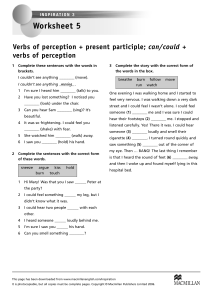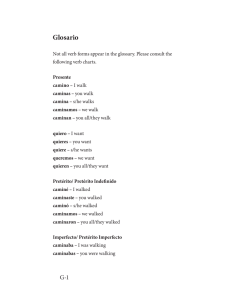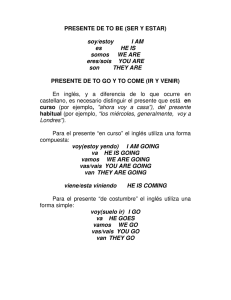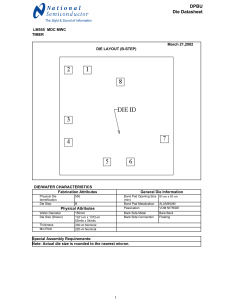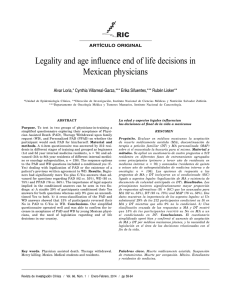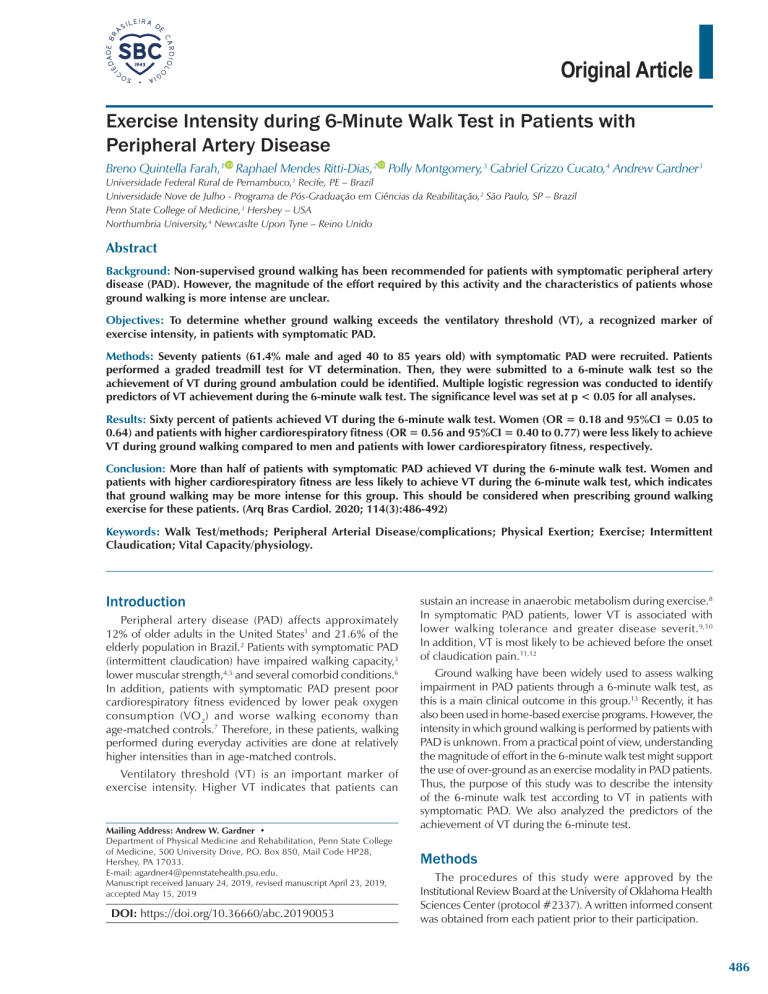
Original Article Exercise Intensity during 6-Minute Walk Test in Patients with Peripheral Artery Disease Breno Quintella Farah,1 Raphael Mendes Ritti-Dias,2 Polly Montgomery,3 Gabriel Grizzo Cucato,4 Andrew Gardner3 Universidade Federal Rural de Pernambuco,1 Recife, PE – Brazil Universidade Nove de Julho - Programa de Pós-Graduação em Ciências da Reabilitação,2 São Paulo, SP – Brazil Penn State College of Medicine,3 Hershey – USA Northumbria University,4 Newcaslte Upon Tyne – Reino Unido Abstract Background: Non-supervised ground walking has been recommended for patients with symptomatic peripheral artery disease (PAD). However, the magnitude of the effort required by this activity and the characteristics of patients whose ground walking is more intense are unclear. Objectives: To determine whether ground walking exceeds the ventilatory threshold (VT), a recognized marker of exercise intensity, in patients with symptomatic PAD. Methods: Seventy patients (61.4% male and aged 40 to 85 years old) with symptomatic PAD were recruited. Patients performed a graded treadmill test for VT determination. Then, they were submitted to a 6-minute walk test so the achievement of VT during ground ambulation could be identified. Multiple logistic regression was conducted to identify predictors of VT achievement during the 6-minute walk test. The significance level was set at p < 0.05 for all analyses. Results: Sixty percent of patients achieved VT during the 6-minute walk test. Women (OR = 0.18 and 95%CI = 0.05 to 0.64) and patients with higher cardiorespiratory fitness (OR = 0.56 and 95%CI = 0.40 to 0.77) were less likely to achieve VT during ground walking compared to men and patients with lower cardiorespiratory fitness, respectively. Conclusion: More than half of patients with symptomatic PAD achieved VT during the 6-minute walk test. Women and patients with higher cardiorespiratory fitness are less likely to achieve VT during the 6-minute walk test, which indicates that ground walking may be more intense for this group. This should be considered when prescribing ground walking exercise for these patients. (Arq Bras Cardiol. 2020; 114(3):486-492) Keywords: Walk Test/methods; Peripheral Arterial Disease/complications; Physical Exertion; Exercise; Intermittent Claudication; Vital Capacity/physiology. Introduction Peripheral artery disease (PAD) affects approximately 12% of older adults in the United States1 and 21.6% of the elderly population in Brazil.2 Patients with symptomatic PAD (intermittent claudication) have impaired walking capacity,3 lower muscular strength,4,5 and several comorbid conditions.6 In addition, patients with symptomatic PAD present poor cardiorespiratory fitness evidenced by lower peak oxygen consumption (VO 2) and worse walking economy than age‑matched controls.7 Therefore, in these patients, walking performed during everyday activities are done at relatively higher intensities than in age-matched controls. Ventilatory threshold (VT) is an important marker of exercise intensity. Higher VT indicates that patients can Mailing Address: Andrew W. Gardner • Department of Physical Medicine and Rehabilitation, Penn State College of Medicine, 500 University Drive, P.O. Box 850, Mail Code HP28, Hershey, PA 17033. E-mail: [email protected]. Manuscript received January 24, 2019, revised manuscript April 23, 2019, accepted May 15, 2019 DOI: https://doi.org/10.36660/abc.20190053 sustain an increase in anaerobic metabolism during exercise.8 In symptomatic PAD patients, lower VT is associated with lower walking tolerance and greater disease severit.9,10 In addition, VT is most likely to be achieved before the onset of claudication pain.11,12 Ground walking have been widely used to assess walking impairment in PAD patients through a 6-minute walk test, as this is a main clinical outcome in this group.13 Recently, it has also been used in home-based exercise programs. However, the intensity in which ground walking is performed by patients with PAD is unknown. From a practical point of view, understanding the magnitude of effort in the 6-minute walk test might support the use of over-ground as an exercise modality in PAD patients. Thus, the purpose of this study was to describe the intensity of the 6-minute walk test according to VT in patients with symptomatic PAD. We also analyzed the predictors of the achievement of VT during the 6-minute test. Methods The procedures of this study were approved by the Institutional Review Board at the University of Oklahoma Health Sciences Center (protocol #2337). A written informed consent was obtained from each patient prior to their participation. 486 Farah et al. Effort during 6-minute walk test Original Article Recruitment and Patients Ankle Brachial Index PAD patients classified as Rutherford Grade I and Category 1 to 3 were evaluated at the Clinical Research Center at the University of Oklahoma Health Sciences Center. Patients arrived fasted, but were permitted to take their usual medications. Patients were recruited by referrals from the Health Sciences Center vascular clinics, as well as by newspaper advertisements for possible enrollment into an exercise study.14,15 However, patients were included in the study if they fully met the following criteria: (a) graded treadmill test limited by intermittent claudication symptoms and (b) an ankle brachial index (ABI) ≤ 0.90 at rest, or an ABI ≤ 0.73 after exercise.1 ABI was obtained after 10 minutes of supine rest by measuring the ankle and brachial systolic blood pressure using Doppler technique in the brachial artery and both posterior tibial and dorsalis pedis arteries. The highest value between the two measurements of arterial pressure from each leg was recorded, and the leg yielding the lowest ABI was used in the analyses, as previously described.20 Patients were excluded if they met any of the following criteria: (a) inability to obtain an ABI measure due to non‑compressible vessels (ABI ≥ 1.40), (b) asymptomatic PAD determined from their medical history and verified upon the graded treadmill test, (c) exercise tolerance during progressive treadmill test limited by factors other than claudication symptoms (e.g. clinically significant electrocardiographic changes during exercise indicative of myocardial ischemia, dyspnea, poorly controlled blood pressure), (d) failure to achieve VT during treadmill exercise, (e) inability to complete the 6-minute walk test without stopping, and (f) failure to complete the testing within three weeks. Study Design This study was divided into three steps: 1) clinical examination, 2) graded treadmill test, and, 3) 6-minute walk test. Step 1 included evaluations for medical history, anthropometry, and ankle-brachial index. During step 2, patients performed a progressive graded cardiopulmonary treadmill test until maximal claudication pain, in order to obtain the VT. In step 3, the 6-minute walk test was applied aiming to identify the patients who did not and those who did achieve VT (Figure 1). The details of all evaluations are described below. Medical History and Anthropometry Demographic information, height, weight, body mass index, waist circumference, claudication history, physical examination and comorbid conditions (osteoarthritis, obesity, hypertension, diabetes, dyslipidemia, metabolic syndrome and heart disease) were assessed at the beginning of the study by a physician. Obesity was defined as body mass index > 30 kg/m2.16 Hypertension was defined as systolic blood pressure ≥ 140 mmHg or diastolic blood pressure ≥ 90 mmHg, or use of anti-hypertensive medication.16 Diabetes was defined as fasting blood glucose ≥ 126 mg/dl, or use of hypoglycemic medication.17 Dyslipidemia was defined as triglycerides ≥ 150 mg/dl, LDL-C ≥ 130 mg/dl, total cholesterol ≥ 200 mg/dl or HDL-C ≤ 40 mg/dl (men) and ≤ 50 mg/dl (women), or use of lipid-lowering medication.18 Metabolic syndrome was defined as three or more of the following components: (1) abdominal obesity (waist circumference >102 cm in men and > 88 cm in women), (2) elevated triglycerides (>150 mg/dl), (3) reduced HDL-C (< 40 mg/dl in men and < 50 mg/dl in women), (4) elevated blood pressure (> 130/85 mmHg), and (5) elevated fasting glucose (> 110 mg/dl), as well as diagnosis of diabetes.19 487 Arq Bras Cardiol. 2020; 114(3):486-492 Graded Treadmill Test A graded treadmill test was used to obtain the VT and to assess walking capacity. Patients performed a progressive graded cardiopulmonary treadmill test until maximal claudication pain, as previously described.21 The test started at 2 mph with 0% grade and the workload was increased 2% every 2 minutes. All patients were informed of the test protocol before being submitted to it. Oxygen consumption (VO2) was continuously measured by a metabolic cart (Medical Graphics Corp., St Paul, MN), and averages of 30s were applied for analysis. The VT was visually detected by two experienced evaluators and defined as a nonlinear increase in respiratory quotient, carbon dioxide production and ventilation, as well as the increase in end‑tidal oxygen pressure. The following variables were analyzed: oxygen uptake (VO2), carbon dioxide output (VCO2), ventilatory equivalent (VE), ventilatory equivalent for O2 (VE/VO2), ventilatory equivalent for CO2 (VE/VO2), end-tidal oxygen (PETO2) and carbon dioxide partial pressures (PETCO2), and respiratory exchange ratio, as previously described.22 A third researcher compared the results to check possible discrepancies in the determination of VT between evaluators. In this case, the determination of VT was repeated by both evaluators and the third evaluator made the final determination. Patients not presenting any of these respiratory parameters during the progressive graded cardiopulmonary treadmill test were considered to not have achieved the VT and were therefore excluded from the sample. Claudication Measurements and Peak Oxygen Uptake The claudication onset time was defined as the walking time at which the patient first experienced leg pain during the treadmill test, and the peak walking time was defined as the walking time at which the patients could not continue walking due the leg pain. VO2 peak was defined as the 30-second window with the highest VO2 achieved during the treadmill test. Using these procedures, the test-retest intra-class reliability coefficients are r = 0.89 for claudication onset time and r = 0.93 for peak walking time.24 6-minute Walk Test A trained technician administered the 6-minute walk test which was conducted in a 30-meter long corridor. Subjects were instructed to walk as many laps around the cones as possible while bearing a light weight (0.8 kg), portable oxygen uptake unit (COSMED K4 b2, COSMED USA, Inc, Chicago, IL) which continuously measured oxygen uptake via indirect calorimetry. The technician was blinded to the VT results, and the test was performed following the standardized instructions, as previously described.23 VO2 was obtained breath-by-breath and then Farah et al. Effort during 6-minute walk test Original Article Clinical examination Graded treadmill test 6-minute walk test Medical history Anthropometry Ankle brachial index Ventilatory thereshold (VT) Achieve VT Did not achieve VT Figure 1 – Study design. averaged per each minute during the test, which allowed for the identification of patients who achieved VT. For this, patients were supposed to have completed the test without stopping after intermittent claudication symptoms. Thus, patients were divided into two groups: those who did not achieve VT and those who did achieve VT during ground walking. Statistical Analysis All statistical analyses were made in the Statistical Package for the Social Sciences software – SPSS/PASW version 20 (IBM Corp, New York, USA). Normality of data was checked by the Shapiro-Wilk test. Continuous variables were summarized as mean and standard deviation, whereas categorical variables were expressed as relative frequency. Patients were grouped according to whether or not they achieved VT, and the clinical characteristics between groups were compared by the independent t-test for continuous variables and the chi-square test for categorical variables. Multiple logistic regression was conducted to identify whether demographic data, cardiovascular risk factors, comorbid conditions, ABI and walking capacity are predictors of achieving VT during the 6-minute walk test. To this end, stepwise backward techniques were used to enter covariates into the model using only variables with p < 0.30 in the bivariate analyses. In the multiple regression, only variables with p < 0.05 remained in the final model. The Hosmer-Lemeshow test was used to assess the model’s goodness-of-fit. The significance level was set at p < 0.05 for all analyses. Results One hundred and thirty-three patients performed the 6-minute walk test. Among them, 63 stopped during the test due to claudication symptoms and were excluded from the analysis. Among the 70 patients who did not stop during the test, the VT was achieved during the 6-minute walk test by 42 patients (60%) and was not achieved by 28 patients (40%). Table 1 shows the comparison of clinical characteristics of patients who achieved and who did not achieve the VT during 6-minute walk test. VO2 at VT obtained during the treadmill test was higher in patients who did not achieve VT during the 6-minute walk test in comparison with patients who achieved it (p < 0.05). Moreover, the ankle brachial index was higher in patients who did not achieve VT in comparison with patients who did (p < 0.05). Table 2 shows the predictors to achieve the VT during the 6-minute walk test. Women were less likely to achieve VT during 6-minute walk test than men (p < 0.05). Moreover, patients with higher VO2 at VT were less likely to achieve the VT during 6-minute walk test (p < 0.05). Table 3 shows the comparisons by sex. In women, the prevalence of obesity was higher and cardiorespiratory fitness was lower as compared to men (p < 0.05). VO2 peak in both the 6-minute walk test and the treadmill test was higher in men than in women (p < 0.05). Discussion The main findings of the study were: a) 60% of symptomatic PAD patients did achieve the VT during 6 minute-walk test, and b) women and patients with higher VO2 at VT obtained during the treadmill test were less likely to achieve VT in the 6-minute-walk test. VT is defined as the exercise intensity above which metabolic predominance changes from aerobic to anaerobic,8 providing information about aerobic capacity during exercise. In patients with symptomatic PAD, VT have been associated with walking tolerance and disease severity.9,10 In this study, 60% of patients achieved VT in the 6-minute walk test, indicating that for most patients with symptomatic PAD this ground walking is a relatively high-intensity exercise. This could partially explain the lower daily physical activity levels and higher time spent in sedentary behavior in these patients.25,26 Therefore, the intensity in which ground walking is performed by most patients with PAD demands a fairly high effort, which suggests that this exercise has potential to improve functional capacity of patients with PAD and, therefore, endorses the use of home-based programs to improve cardiorespiratory fitness. On the other hand, almost 40% of the patients did not achieve VT in the 6-minute walk test. The most plausible hypothesis for part of PAD patients not achieving VT was that the ground walking was not intense enough to elicit VT achievement. This hypothesis is corroborated by the fact that patients with higher cardiorespiratory fitness were less likely to achieve the VT during ground walking. Women were less likely to exceed VT during the 6-minute walk test than men, indicating that ground walking is performed at a lower relative intensity by women than by men. This is surprising given previous studies27,28 have shown that women with symptomatic PAD have lower walking capacity,29,30 are less physically active29,30 and report more barriers to practicing physical activity compared to men.31 In addition, women present more adverse calf muscle characteristics and lower VO2 peak than men.32 Arq Bras Cardiol. 2020; 114(3):486-492 488 Farah et al. Effort during 6-minute walk test Original Article Table 1 – Characteristics of patients with intermittent claudication included in the study Variables Did not achieve VT (n = 28) Achieved VT (n = 42) p Age, years 66.1 ± 9.9 66.9 ± 10.2 0.745 Body mass index, kg-1m2 29.9 ± 6.0 29.0 ± 5.6 0.486 Ankle brachial index 0.85 ± .21 0.71 ± .21 0.013 Claudication onset time, seconds 297 ± 192 271 ± 191 0.572 Peak walking time, seconds 576 ± 266 541 ± 219 0.542 Six-minute pain-free distance, meters 189 ± 144 214 ± 96 0.417 Six-minute walk test, meters 382 ± 73 399 ± 67 0.332 VO2 at VT, mL.kg-1.min-1 12.0 ± 2.4 10.1 ± 1.9 < 0.001 VO2 peak, mL.kg-1.min-1 13.9 ± 3.7 13.5 ± 3.4 0.627 Sex, % women 52 48 0.109 Diabetes mellitus, % yes 46 54 0.419 Hypertension, % yes 41 59 0.789 Dyslipidemia, % yes 38 62 0.436 Coronary artery disease, % yes 13 88 0.093 COPD, % yes 53 47 0.211 VT: ventilatory threshold; VO2: oxygen uptake; COPD: chronic obstructive pulmonary disease. Table 2 – Multiple logistic regression model predicting achieved ventilatory threshold during the 6-minute walk test in patients with intermittent claudication Dependent variable Independent variables Achieved VT β (EP) OR 95%CI p Sex, men = reference -1.72 (0.65) 0.18 0.05 – 0.64 0.008 Oxygen uptake at VT, mL.kg-1.min-1 - 0.58 (0.17) 0.56 0.40 – 0.77 < 0.001 VT: ventilatory threshold; β (EP): Regression coefficient (error-standard); OR: odds-ratio. 95% CI: 95% confidence interval. Hosmer-Lemeshow test: χ 2 = 9.607, p = 0.298. Table 3 – Comparison of clinical parameters of intermittent claudication between men and women included in the study Variables Women (n = 28) Men (n = 43) p Age, years 64.9 ± 9.5 67.6 ± 10.3 0.265 Body mass index, kg-1m2 31.1 ± 6.6 28.3 ± 5.0 0.044 Ankle brachial index 0.80 ± .23 0.75 ± .22 0.258 Claudication onset time, seconds 241 ± 164 306 ± 203 0.330 Peak walking time, seconds 507 ± 196 585 ± 256 0.180 VO2 at VT, mL.kg-1.min-1 10.3 ± 2.3 11.3 ± 2.2 0.035 12.0 ± 2.9 14.7 ± 3.4 0.001 11.1 ± 3.0 12.5 ± 2.1 0.034 VO2 peak in treadmill test, mL.kg .min -1 -1 VO2 peak in 6-MWT, mL.kg-1.min-1 6-MWT: 6-minute walk test. Some practical messages can be draw from this study. The 6-minute walk test is harder for men and patients with low cardiorespiratory fitness. Is recommended that exercise training intensity should be performed above VT in order to improve cardiovascular function in cardiac patients and the elderly.33,34 Considering that the 6-minute walk test simulates an over-ground walk, the current results support its use as an exercise mode to increase both daily physical activity and cardiorespiratory fitness in men and in patients with low cardiorespiratory fitness. However, in 489 Arq Bras Cardiol. 2020; 114(3):486-492 women and in patients with higher cardiorespiratory fitness, over‑ground walking may not be enough to improve activity and fitness levels. The cross-sectional design of this study is a limitation, as no causality can be inferred. Patients with severe cardiac disease and asymptomatic PAD or PAD more severe than claudication were excluded in the screening; therefore, the results can be extended only to our current sample of patients with claudication. Given we were not able to precisely identify VT in patients who stopped during the 6-minute walk test, generalization is also Farah et al. Effort during 6-minute walk test Original Article restricted to these patients. In addition, to accurately detect the VT in the 6-minute walk test, we only included patients that did not stop while performing it. These findings are also limited by the relatively small sample size, particularly when it comes to patients who did not achieve the VT. Conclusion More than half of patients with symptomatic PAD achieved VT during the 6-minute walk test. Men and patients with lower cardiorespiratory fitness are more likely to achieve VT during the 6-minute walk test. Acknowledgments This study was funded by the National Institute on Aging (R01-AG-24296), Oklahoma Center for Advancement of Science and Technology (HR09-035), and OUHSC General Clinical Research Center (M01-RR-14467) from National Center for Research Resources. Author contributions Conception and design of the research: Farah BQ, Dias RR, Cucato G, Gardner A; Acquisition of data: Montgorery P, Gardner A; Analysis and interpretation of the data: Farah BQ, Dias RR, Gardner A; Statistical analysis: Farah BQ; Obtaining financing: Gardner A; Writing of the manuscript: Farah BQ, Dias RR, Cucato G; Critical revision of the manuscript for intellectual content: Montgorery P, Gardner A. Potential Conflict of Interest No potential conflict of interest relevant to this article was reported. Sources of Funding This study was funded by National Institute on Aging (R01AG-24296), Oklahoma Center for Advancement of Science and Technology (HR09-035), and OUHSC General Clinical Research Center (M01-RR-14467) of National Center for Research Resourcer. Study Association This study is not associated with any thesis or dissertation work. Ethics approval and consent to participate This study was approved by the Ethics Committee of the University of Oklahoma Health Sciences Center under the protocol number 2337. All the procedures in this study were in accordance with the 1975 Helsinki Declaration, updated in 2013. Informed consent was obtained from all participants included in the study. References 1. 2. 3. 4. 5. Aboyans V, Ricco JB, Bartelink MEL, Bjorck M, Brodmann M, Cohnert T, et al. 2017 ESC Guidelines on the Diagnosis and Treatment of Peripheral Arterial Diseases, in collaboration with the European Society for Vascular Surgery (ESVS): Document covering atherosclerotic disease of extracranial carotid and vertebral, mesenteric, renal, upper and lower extremity arteriesEndorsed by: the European Stroke Organization (ESO)The Task Force for the Diagnosis and Treatment of Peripheral Arterial Diseases of the European Society of Cardiology (ESC) and of the European Society for Vascular Surgery (ESVS). Eur Heart J. 2018;39(9):763-816. Makdisse M, Pereira Ada C, Brasil Dde P, Borges JL, Machado-Coelho GL, Krieger JE, et al. Prevalence and risk factors associated with peripheral arterial disease in the Hearts of Brazil Project. Arquivos brasileiros de cardiologia. 2008;91(6):370-82. McDermott MM, Greenland P, Ferrucci L, Criqui MH, Liu K, Sharma L, et al. Lower extremity performance is associated with daily life physical activity in individuals with and without peripheral arterial disease. J Am Geriatr Soc. 2002;50(2):247-55. Camara LC, Ritti-Dias RM, Meneses AL, D’Andrea Greve JM, Filho WJ, Santarem JM, et al. Isokinetic strength and endurance in proximal and distal muscles in patients with peripheral artery disease. Ann Vasc Surg. 2012;26(8):1114-9. Meneses AL, Farah BQ, Ritti-Dias RM. Muscle function in individuals with peripheral arterial obstructive disease: A systematic review. Motricidade. 2012;8(1):86-96. 6. Farah BQ, Ritti-Dias RM, Cucato GG, Chehuen Mda R, Barbosa JP, Zeratti AE, et al. Effects of clustered comorbid conditions on walking capacity in patients with peripheral artery disease. Ann Vasc Surg. 2014;28(2):279-83. 7. Womack CJ, Sieminski DJ, Katzel LI, Yataco A, Gardner AW. Oxygen uptake during constant-intensity exercise in patients with peripheral arterial occlusive disease. Vasc Med. 1997;2(3):174-8. 8. Wasserman K, Hansen J, Sue D, Whipp B, Casaburi R. Principle of Exercise Testing and Interpretation. In: 2nd, ed. Washington, DC: Lea & Febinger; 1994. 241 p. 9. Farah BQ, Ritti-Dias RM, Cucato GG, Meneses AL, Gardner AW. Clinical predictors of ventilatory threshold achievement in patients with claudication. Med Sci Sports Exerc. 2015;47(3):493-7. 10. Rocha CM, Cucato GG, Barbosa JAS, Costa RL, Ritti-Dias RM, Wolosker N, et al. Ventilatory threshold is related to walking tolerance in patients with intermittent claudication. VASA. 2012;41(4):275-81. 11. Cucato GG, Chehuen Mda R, Costa LA, Ritti-Dias RM, Wolosker N, Saxton JM, et al. Exercise prescription using the heart of claudication pain onset in patients with intermittent claudication. Clinics (Sao Paulo). 2013;68(7):974-8. 12. Ritti-Dias RM, de Moraes Forjaz CL, Cucato GG, Costa LA, Wolosker N, Marucci MFN. Pain threshold is achieved at intensity above anaerobic threshold in patients with intermittent claudication. J Cardiopulm Rehabil Prev. 2009;29(6):396-401. 13. Montgomery PS, Gardner AW. The clinical utility of a six-minute walk test in peripheral arterial occlusive disease patients. J Am Geriatr Soc. 1998;46(6):706-11. 14. Gardner AW, Parker DE, Montgomery PS, Blevins SM. Step-monitored home exercise improves ambulation, vascular function, and inflammation in symptomatic patients with peripheral artery disease: a randomized controlled trial. J Am Heart Assoc. 2014;3(5):e001107. 15. Gardner AW, Parker DE, Montgomery PS, Scott KJ, Blevins SM. Efficacy of quantified home-based exercise and supervised exercise in patients with intermittent claudication: a randomized controlled trial. Circulation. 2011;123(5):491-8. Arq Bras Cardiol. 2020; 114(3):486-492 490 Farah et al. Effort during 6-minute walk test Original Article 16. Chobanian AV, Bakris GL, Black HR, Cushman WC, Green LA, Izzo JL, Jr., et al. The Seventh Report of the Joint National Committee on Prevention, Detection, Evaluation, and Treatment of High Blood Pressure: the JNC 7 report. JAMA. 2003;289(19):2560-72. 17. American Diabetes A. Diagnosis and classification of diabetes mellitus. Diabetes Care. 2014;37 Suppl 1S81-90. 18. National Cholesterol Education Program Expert Panel on Detection E, Treatment of High Blood Cholesterol in A. Third Report of the National Cholesterol Education Program (NCEP) Expert Panel on Detection, Evaluation, and Treatment of High Blood Cholesterol in Adults (Adult Treatment Panel III) final report. Circulation. 2002;106(25):3143-421. 19. Expert Panel on Detection E, Treatment of High Blood Cholesterol in A. Executive Summary of The Third Report of The National Cholesterol Education Program (NCEP) Expert Panel on Detection, Evaluation, And Treatment of High Blood Cholesterol In Adults (Adult Treatment Panel III). JAMA. 2001;285(19):2486-97. 20. Gardner AW, Montgomery PS. Comparison of three blood pressure methods used for determining ankle/brachial index in patients with intermittent claudication. Angiology. 1998;49(9):723-8. 21. Gardner AW, Skinner JS, Cantwell BW, Smith LK. Progressive vs single-stage treadmill tests for evaluation of claudication. Medicine and science in sports and exercise. 1991;23(4):402-8. 22. Wasserman K, Whipp BJ, Koyl SN, Beaver WL. Anaerobic threshold and respiratory gas exchange during exercise. J Appl Physiol. 1973;35(2):236-43. 491 25. Farah BQ, Ritti-Dias RM, Cucato GG, Montgomery PS, Gardner AW. Factors Associated with Sedentary Behavior in Patients with Intermittent Claudication. Eur J Vasc Endovasc Surg. 2016;52(6):809-14. 26. Barbosa JP, Farah BQ, Chehuen M, Cucato GG, Farias Junior JC, Wolosker N, et al. Barriers to physical activity in patients with intermittent claudication. Int J Behav Med. 2015;22(1):70-6. 27. Gardner AW. Sex differences in claudication pain in subjects with peripheral arterial disease. Med Sci Sports Exerc. 2002;34(11):1695-8. 28. McDermott MM, Greenland P, Liu K, Criqui MH, Guralnik JM, Celic L, et al. Sex differences in peripheral arterial disease: leg symptoms and physical functioning. J Am Geriatr Soc. 2003;51(2):222-8. 29. Gardner AW, Parker DE, Montgomery PS, Khurana A, Ritti-Dias RM, Blevins SM. Gender differences in daily ambulatory activity patterns in patients with intermittent claudication. J Vasc Surg. 2010;52(5):1204-10. 30. Gerage AM, Correia MA, Longano PM, Palmeira AC, Domingues WJR, Zerati AE, et al. Physical activity levels in peripheral artery disease patients. Arq Bras Cardiol. 2019;113(3):410-6. 31. de Sousa ASA, Correia MA, Farah BQ, Saes G, Zerati AE, Puech-Leao P, et al. Barriers and Levels of Physical Activity in Symptomatic Peripheral Artery Disease Patients: Comparison Between Women and Men. J Aging Phys Act. 2019 May 30:1-6. 32. McDermott MM, Ferrucci L, Liu K, Guralnik JM, Tian L, Kibbe M, et al. Women with peripheral arterial disease experience faster functional decline than men with peripheral arterial disease. J Am Coll Cardiol. 2011;57(6):707-14. 23. Gardner AW, Skinner JS, Cantwell BW, Smith LK. Progressive vs singlestage treadmill tests for evaluation of claudication. Med Sci Sports Exerc. 1991;23(4):402-8. 33. Temfemo A, Chlif M, Mandengue SH, Lelard T, Choquet D, Ahmaidi S. Is there a beneficial effect difference between age, gender, and different cardiac pathology groups of exercise training at ventilatory threshold in cardiac patients? Cardiol J. 2011;18(6):632-8. 24. Gardner AW. Reliability of transcutaneous oximeter electrode heating power during exercise in patients with intermittent claudication. Angiology. 1997;48(3):229-35. 34. Weltman A, Seip RL, Snead D, Weltman JY, Haskvitz EM, Evans WS, et al. Exercise training at and above the lactate threshold in previously untrained women. Int J Sports Med. 1992;13(3):257-63. Arq Bras Cardiol. 2020; 114(3):486-492 Farah et al. Effort during 6-minute walk test Original Article This is an open-access article distributed under the terms of the Creative Commons Attribution License Arq Bras Cardiol. 2020; 114(3):486-492 492
